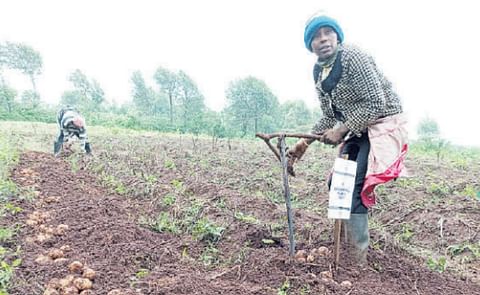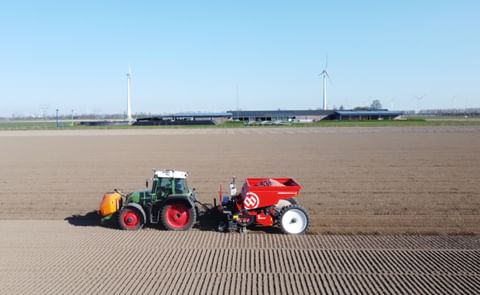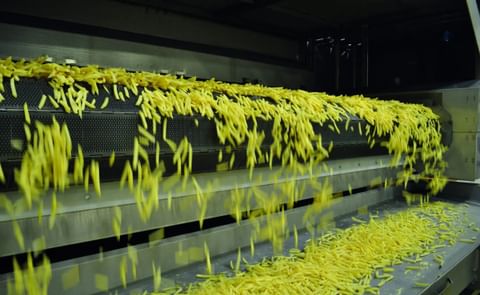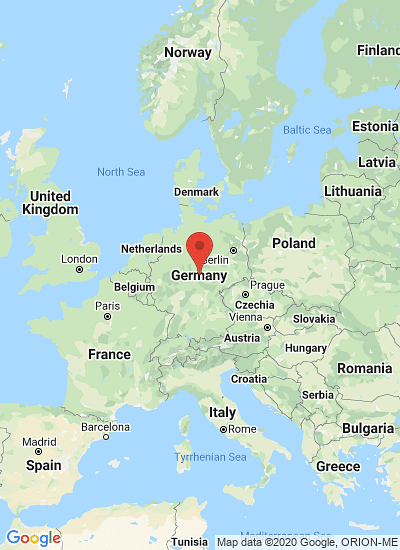A specimen of the herbarium Solanum tuberosum (potato) collected and preserved on the Chonos archipelago in Chile by Charles Darwin during his expedition on the HMS 'Beagle'. (Courtesy: Cambridge University Herbarium)
Origins of the European potato
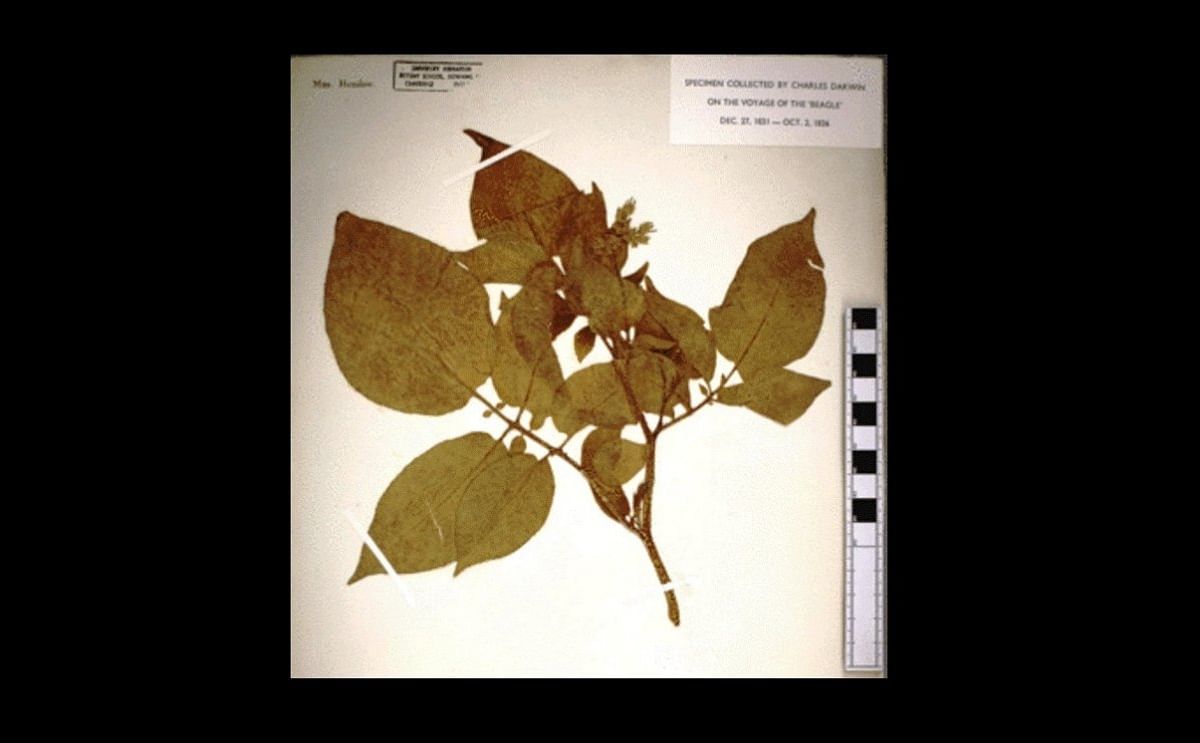
Plants collected by Darwin have helped reveal the ancestry of European potatoes. New genetic analysis, led by scientists from the Max Planck Institute for Developmental Biology in Germany, settles nearly 100 years of debate about the origins of the European potato.
Russian scholars thought that modern European potato came from Chile while English researchers suggested an Andean origin. The new results show that the origins of the European potato are in fact rooted in both regions of South America.
To trace the ancestry of the potato, the authors extracted DNA from 88 samples that included landraces, modern cultivars and historical specimens kept in herbaria. The oldest was a 1660 specimen found in the Sloane herbarium at London's Natural History Museum. To the author's knowledge, this is the oldest herbarium specimen of any plant from which genome-wide DNA data has been successfully retrieved.
The first potatoes collected by Europeans were taken from the highlands of the equatorial Andes in the 16thcentury. At this latitude, they were adapted to short days. When they were first introduced to Europe, tubers would only develop in late autumn as the days shortened, mimicking the day length and temperature cues of their original habitat. This allowed little time for tubers to grow in size before plants were killed by the first frosts. Rafal Gutaker, from the Max Planck Institute for Developmental Biology:
The new research tracks the emergence of this adaptation in Europe and traces it to the 19th century, coinciding with an influx of Chilean potatoes. The period also coincides with a transformation in the cultivation of potatoes in Europe. After a slow start, cultivation gained momentum between the 18thand 19thcenturies and by the middle of the 19th century, the potato was Ireland's main staple crop.
Beverley Glover from Cambridge University Herbarium, which curates the Darwin collection:
From 1846 to 1891, Andean ancestry made a resurgence, which coincides with the potato late blight epidemic of 1845 to 1847 that triggered the Irish Potato Famine. This shift suggests that farmers may have reintroduced older potato stocks to overcome losses of pathogen-susceptible crops.
The analysis also suggests that genetic diversity introduced from South America was mixed in later years with wild potato species, used to build resistance to plant pathogens.
Hernán Burbano, the lead author, from the Max Planck Institute for Developmental Biology:
Russian scholars thought that modern European potato came from Chile while English researchers suggested an Andean origin. The new results show that the origins of the European potato are in fact rooted in both regions of South America.
To trace the ancestry of the potato, the authors extracted DNA from 88 samples that included landraces, modern cultivars and historical specimens kept in herbaria. The oldest was a 1660 specimen found in the Sloane herbarium at London's Natural History Museum. To the author's knowledge, this is the oldest herbarium specimen of any plant from which genome-wide DNA data has been successfully retrieved.
The first potatoes collected by Europeans were taken from the highlands of the equatorial Andes in the 16thcentury. At this latitude, they were adapted to short days. When they were first introduced to Europe, tubers would only develop in late autumn as the days shortened, mimicking the day length and temperature cues of their original habitat. This allowed little time for tubers to grow in size before plants were killed by the first frosts. Rafal Gutaker, from the Max Planck Institute for Developmental Biology:
“Plants introduced from Peru would have produced the smallest potatoes you've ever seen on your plate and would have sliced into chips smaller than matchsticks.”Introduction of potatoes from Chile
“Overcoming short-day dependency for tuberization was the most important milestone in the widespread success of potato-growing.”
The new research tracks the emergence of this adaptation in Europe and traces it to the 19th century, coinciding with an influx of Chilean potatoes. The period also coincides with a transformation in the cultivation of potatoes in Europe. After a slow start, cultivation gained momentum between the 18thand 19thcenturies and by the middle of the 19th century, the potato was Ireland's main staple crop.
Beverley Glover from Cambridge University Herbarium, which curates the Darwin collection:
“Potato specimens from 19th-century South America are very rare. The authors would not have been able to determine with certainty the Chilean ancestry of potato without the samples collected by Darwin in 1834, which are preserved for future research in the Cambridge University Herbarium.”Contemporary Chilean potatoes are very similar to modern potatoes in Europe. However, they're also very different from historical Chilean samples, including those collected by Darwin. The initial introductions to Europe from the Andes and then from Chile are not the full story.
From 1846 to 1891, Andean ancestry made a resurgence, which coincides with the potato late blight epidemic of 1845 to 1847 that triggered the Irish Potato Famine. This shift suggests that farmers may have reintroduced older potato stocks to overcome losses of pathogen-susceptible crops.
The analysis also suggests that genetic diversity introduced from South America was mixed in later years with wild potato species, used to build resistance to plant pathogens.
Hernán Burbano, the lead author, from the Max Planck Institute for Developmental Biology:
“Potatoes are one of the most important staple crops for food security. Our findings show the importance of maintaining diverse landraces and wild relatives of crops to ensure their success in an uncertain future, governed by the effects of climate change and the ever-present threat of new diseases.”
¿Te gustaría recibir noticias como esta por correo electrónico? ¡Únete y suscríbete!
NEW! Join Our BlueSky ¡Canal para actualizaciones periódicas!
Contenido Patrocinado
Contenido Patrocinado
Contenido Patrocinado
Contenido Patrocinado
Contenido Patrocinado

